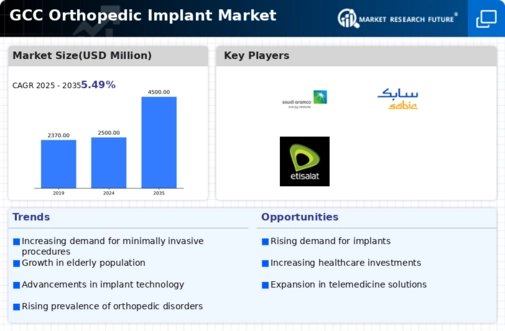Increasing Aging Population
The orthopedic implant market is experiencing growth due to the increasing aging population in the GCC region. As individuals age, they often face musculoskeletal issues, leading to a higher demand for orthopedic procedures. It is estimated that by 2030, the population aged 60 and above in the GCC will reach approximately 20% of the total population. This demographic shift is likely to drive the need for joint replacements and other orthopedic interventions, thereby expanding the orthopedic implant market. Furthermore, the prevalence of age-related conditions such as osteoarthritis is expected to rise, necessitating advanced orthopedic solutions. The healthcare systems in the GCC are adapting to this trend by enhancing their orthopedic services, which may further stimulate market growth.
Expansion of Medical Tourism
The orthopedic implant market is experiencing growth due to the expansion of medical tourism in the GCC region. Countries such as the UAE and Saudi Arabia are becoming popular destinations for patients seeking orthopedic surgeries, attracted by high-quality healthcare services and competitive pricing. The medical tourism market in the GCC is projected to reach $25 billion by 2025, with orthopedic procedures being a significant contributor. This influx of international patients is likely to drive demand for orthopedic implants, as healthcare facilities enhance their offerings to cater to diverse patient needs. The growth of medical tourism may also encourage local healthcare providers to invest in advanced technologies and improve service delivery, further benefiting the orthopedic implant market.
Rising Healthcare Expenditure
The orthopedic implant market is positively influenced by the rising healthcare expenditure in the GCC countries. Governments are increasingly investing in healthcare infrastructure, aiming to improve the quality of medical services. For instance, healthcare spending in the GCC is projected to reach $104 billion by 2025, reflecting a growth rate of around 7% annually. This increase in funding allows for the procurement of advanced orthopedic implants and technologies, enhancing surgical outcomes. Additionally, the expansion of private healthcare facilities is providing patients with more options for orthopedic procedures, further driving demand. As healthcare expenditure continues to rise, the orthopedic implant market is likely to benefit from improved access to innovative treatments and surgical interventions.
Growing Awareness of Orthopedic Health
Growing awareness of orthopedic health among the population in the GCC is benefiting the market. Educational campaigns and health initiatives are increasingly focusing on the importance of musculoskeletal health, leading to early diagnosis and treatment of orthopedic conditions. This heightened awareness is likely to result in more individuals seeking medical advice for joint pain and related issues, thereby increasing the demand for orthopedic surgeries. Moreover, the rise of social media and digital platforms has facilitated the dissemination of information regarding orthopedic health, encouraging proactive health management. As awareness continues to grow, the orthopedic implant market may see a corresponding increase in the number of procedures performed.
Technological Innovations in Surgical Techniques
The orthopedic implant market is being propelled by technological innovations in surgical techniques. Advancements such as minimally invasive surgery and robotic-assisted procedures are transforming the landscape of orthopedic interventions. These technologies not only enhance surgical precision but also reduce recovery times for patients. In the GCC, hospitals are increasingly adopting these innovative techniques, which may lead to improved patient outcomes and satisfaction. The integration of advanced imaging technologies and 3D printing in implant design is also contributing to the customization of orthopedic solutions. As these technologies continue to evolve, they are likely to play a crucial role in shaping the future of the orthopedic implant market.















Leave a Comment